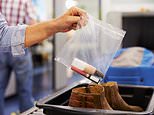
With the hassle of taking off shoes, separating liquids, and removing laptops from bags, getting through airport security can be a rigmarole.
But the rules that are in place are there for good reason.
Here we break down the rationale behind the steps that travellers are required to take before passing through the scanners. Plus, we reveal a few tips for speeding up the process to ensure your holiday gets off to a flying start.
REMOVING YOUR LAPTOP FROM YOUR BAG
Why do we need to place laptops in a separate tray to the rest of our belongings when heading through security? Doug Drury, who is the Head of Aviation at CQUniversity Australia, explains that the main reason is that ‘battery and other mechanical components are too dense for X-rays to penetrate effectively – especially if the scanning system is old’.
Laptops must be scanned separately because the device’s ‘battery and other mechanical components are too dense for X-rays to penetrate effectively’, aviation expert Doug Drury reveals
Writing in a piece on The Conversation, he says that with the laptop in your bag, ‘security officials can’t use the screened image to determine whether a risk is present’.
Drury continues: ‘They’ll have to flag the bag for a physical search, which slows everything down. It’s easier if all devices are removed in the first place. A laptop inside a bag can also shield other items from view that may be dangerous. Scanning it separately reveals its internal components on the screen.’
The same applies to other large electrical items such as cameras, hairdryers and iPads.
This rule is on its way out, however, with the introduction of advanced new scanners in airports in the U.S, Holland and in London’s City Airport and Northern England’s Teesside International Airport.
The new CT machines use X-Ray technology to take a high-resolution 3D image of luggage, allowing assessors to view it from every angle and obtain a more detailed view of the contents. Older security scanners only produce a 2D image.
The British government is requiring all major UK airports to use the technology by June 2024.
PUTTING LIQUIDS IN 100ML CONTAINERS
Liquids in hand luggage must be limited to containers of 100ml (3.4oz), unless travellers are using the new scanners in place in airports such as London’s City Airport
This rule was put in place in 2006 after the British Metropolitan Police thwarted a terror plot to detonate liquid explosives on board a series of U.S and Canada-bound flights from the UK.
It was revealed that, as part of the plot, a homemade mixture of chemicals was to be hidden inside run-of-the-mill soft drinks bottles.
After the plot was uncovered, several strict new security measures were put in place in airports around the world – including limiting liquids in hand luggage containers to 100ml (3.4oz). While the rules vary in different countries, the 100ml limit applies in many, including the UK and the U.S.
Gov.uk says that if you take liquids in your hand luggage, they must be held in a single, transparent, resealable plastic bag ‘which holds no more than a litre (35oz) and measures approximately 20cm (8in) by 20cm (8in)’. It adds that ‘contents must fit comfortably inside the bag so it can be sealed’ and the ‘bag must not be knotted or tied at the top’.
Much like the requirement to remove your laptop, however, this rule is also changing with the introduction of advanced scanners. When using these scanners at security, the limit is two litres (70oz) of liquid, rather than 100ml. This is because the new scanners’ detection algorithms call attention to any dubious items that may warrant further inspection – such as liquid explosives.
TAKING OFF YOUR SHOES
TSA says: ‘You will have to remove your shoes. So save yourself the hassle of unbuckling, unzipping or untying and bring them slip-ons’
The reason why we need to remove our shoes in airport security goes back to 2001 when Richard Reid attempted to detonate an explosive device hidden in his shoes on a flight from Paris to Miami.
Passengers were able to subdue him by binding Reid – now known as the ‘shoe bomber’ – with plastic handcuffs, seatbelt extensions and headphone cords, and the plane was diverted to Logan International Airport in Boston.
The shoes-off rule was established by the U.S Department of Homeland Security in 2006, with the Transportation Security Administration (TSA) noting: ‘Based on intelligence pointing to a continuing threat, TSA requires passengers to remove shoes to screen for explosives.’
The rule still stands today, with passengers wearing boots or heels likely to be asked to remove their footwear before passing through the scanners.
The TSA website says: ‘You will have to remove your shoes. So save yourself the hassle of unbuckling, unzipping or untying and bring them slip-ons.’
And the website for London’s Gatwick Airport notes: ‘By removing shoes, metallic jewellery, belts or any other removable items you greatly reduce the chance of activating our walk-through metal detectors, therefore speeding up your journey through security.’
WHY YOUR ELECTRICAL ITEMS NEED TO BE CHARGED
If you’re travelling with electrical goods – such as a laptop – it’s important to make sure they’re charged before you travel.
Gov.uk says: ‘If your device does not switch on when requested, you will not be allowed to take it onto the aircraft.’
This rule is in place to ‘prove it’s an actual working computer’ and not a security threat, aviation expert Drury wrote on The Conversation.
HOW TO GET THROUGH SECURITY FASTER
Paying for a ‘fast track’ service can help speed up the process of getting through security
Many airports offer ‘fast track’ services, taking you through a dedicated lane in security so you can complete the process faster. It costs around £8 at Stansted Airport and from just £5 at Gatwick Airport.
UK consumer watchdog Which? revealed earlier this year: ‘You’re most likely to feel the benefit of fast-track security when travelling at peak times. If your flight is leaving before 10am, this is likely to be the busiest time of day at any airport.’
Meanwhile, if you’ve splashed out on a business class or first class ticket, this often entitles you to pass through a priority lane in security, accelerating the process. This does depend on the airport, however.
Frequent flyers in America ought to sign up for TSA PreCheck, which entitles them to reduced security measures – such as not having to remove their laptops or liquids from their bags – and access to a dedicated lane at security in more than 200 airports.
The TSA PreCheck website notes that in June of this year, ’88 per cent of TSA PreCheck passengers waited less than five minutes’ to get through security. In order to qualify for it, travellers must attend a 10-minute appointment in one of the enrollment centres around the country, which involves fingerprinting for a background check.
You can also monitor the security wait times on apps such as MiFlight or MyTSA. This gives you the chance to relax with a coffee in the departure lounge and make your way through security when queues are at their shortest.
Finally, preparation is key. Having all your liquids pre-separated into a clear plastic bag and wearing shoes that are easy to remove are just some of the ways you can make it through the process more smoothly.
Source link
CHECK OUT: Top Travel Destinations
READ MORE: Travel News



